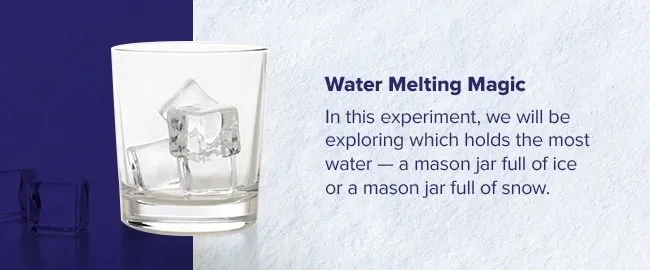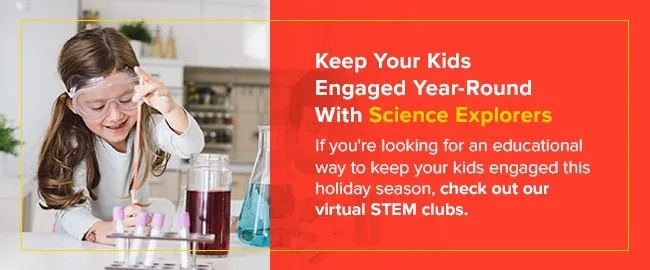In 2020, families learned how to get creative indoors. Parents are exploring new ways to keep their children entertained and engaged in educational activities. At-home STEM activities are important now more than ever because children aren’t getting the same hands-on science, technology, engineering and math experience as they would in a typical school environment.
With the holiday season in full swing, we’ve brainstormed three Christmas STEM activities for kids that you can do using items you likely already have around your house.
1. Fizzy Holiday Fun
This Fizzy Holiday Fun experiment explores the well-known chemical reaction between baking soda and vinegar. It requires minimal setup, and the experiment is safe and easy enough where your children can self-lead their chemistry exploration.
To do this holiday STEM activity at home, you will need:
- Holiday-shaped cookie cutters
- A shallow bowl or dish
- A syringe, or a teaspoon if you don’t have a syringe handy
- Food coloring
- Baking soda
- Vinegar
- Optional glitter
Dig into your cookie cutter collection and look for traditional holiday shapes like Christmas trees, menorahs, snowflakes and candy canes. Add some festive flair by using red or green food coloring and optional gold or silver glitter. Glitter won’t make-or-break your experiment but adds an exciting element that your children will love!
Perform this Fizzy Holiday Fun activity by:
- Place your holiday-shaped cookie cutter in the middle of a shallow dish.
- Fill the cookie cutter with baking soda, about halfway or three-quarters full.
- Use your finger to gently press down and flatten the baking soda.
- Add a few drops of food coloring.
- Sprinkle glitter over the top. Your children can help with steps three to five. It’s a fun way for young children to practice their fine and gross motor skills!
- Before starting the reaction, ask your children what they think will happen when vinegar combines with the baking soda. Listen as they practice their critical thinking and logic skills.
- Instruct your children to fill their syringes with vinegar. Once filled, allow them to pour it onto the baking soda.
Watch as the baking soda fizzes and expands, mixing the colors and glitter and overflowing the dish with the chemical reaction!
Learning Opportunity
The reaction between vinegar and baking soda explores the basics of chemistry.
Vinegar has the chemical formula C 2 H 4 O 2 , and baking soda has the formula NaHCO 3 . When these formulas combine, they create carbon dioxide (CO 2 ), water (H 2 O) and sodium acetate (NaC 2 H 3 O 2 ).
The chemical reaction is as follows:
- C 2 H 4 O 2 + NaHCO 3 turns into NaC 2 H 3 O 2 + H 2 O + CO 2
Break down what each formula means and how to properly read them. Give your children time to think about these formulas, then explain the relationship in a way they will understand.

2. Water Melting Magic
Water Melting Magic is a simple science experiment that practices using controls and variables in the scientific process.
In this experiment, we will be exploring which holds the most water — a mason jar full of ice or a mason jar full of snow . We’ll compare these dependent variables with a mason jar full of regular tap water, the independent variable. The regular tap water doesn’t need to melt, so it won’t change!
For this holiday STEM activity for kids, you will need:
- Three mason jars with lids
- Tap water
- Ice cubes
- Fresh snow
Before starting this experiment, warm up your children’s critical thinking skills by talking about the different forms of water. Then, perform the Water Melting Magic experiment with the following steps:
- Fill the first mason jar with tap water. Seal the lid.
- Fill the second jar with ice cubes. Seal the lid and place it to the left of the first jar.
- Go outside and fill the third jar with snow. Seal the lid and place it to the right of the first jar.
- Ask your children which jar will have the most water once the ice and snow melt. Odds are, they’ll say the third jar packed with snow. The ice cubes have a lot of extra space between each cube, while the snow consumes the entire jar. Without prior knowledge, it’s reasonable to believe that the third jar has the most liquid water in it.
- Wait for the ice and snow to melt.
Once melted, the answer is obvious — the mason jar with the ice cubes has much more water than the mason jar with snow!
Learning Opportunity
Water comes in different forms with different molecule structures. Ice is the solid form of water with tightly packed molecules. Snow is frozen precipitation, made of bonded molecules that form crystallized patterns with a lot of air in between them.
So, although the ice visually appears to have more air and space in the mason jar, the snow actually has more space between each molecule!
3. Candy Cane Play Dough
This Candy Cane Play Dough experiment doubles as a DIY-Christmas present and a fun STEM activity for your kids. Depending on the ingredients you use, you can use this Candy Cane Play Dough as a candy cane-shaped bubble bath or soap bar. Your family and loved ones will adore the thoughtfulness of this DIY gift!
For this at-home Christmas STEM activity, you will need:
- 1/2 cup castile soap or clear, unscented bubble bath
- Peppermint essential oil
- A few teaspoons of corn starch
- 1/2 teaspoon of coconut oil
- Red coloring, either water coloring or non-staining food dye
- Two mixing bowls
- A flat surface for rolling
- Parchment paper
The measurements are forgiving, so feel free to let your children take charge in their cause-and-effect experiment. Practice math skills with your children by measuring each ingredient and encouraging them to follow these instructions:
- Take the soap or unscented bubble bath, and split the 1/2 cup measurement between two bowls.
- Add red coloring into one of the two bowls.
- Add 1/2 teaspoon of coconut oil to both bowls.
- Add a few drops of peppermint essential oil to both bowls.
- Mix both bowl’s mixtures until well combined.
- Put the second bowl to the side.
- In the first bowl, add one teaspoon of corn starch. Knead and mix the mixture. If needed, slowly add more corn starch one teaspoon at a time until the mixture reaches a dough consistency.
- Repeat step seven with the second bowl.
- Lay out a sheet of parchment paper on a flat surface, like a clean counter or cutting board.
- With your red and white play dough completed, take them out of their respective bowls and place them onto the parchment paper.
- Roll out each ball of dough into long snakes.
- Line each play-dough snake parallel to each other and twist them to make a candy cane twist.
- Cut your long, twisted play-dough snake into sections. Then, shape each section into a candy cane shape.
The size of each candy cane depends on your preferences. If you are making candy cane soap bars, then you may want smaller one-use sizes. If you’re making bubble bath bars, consider making them larger for more bubbles.

Keep Your Kids Engaged Year-Round With Science Explorers Virtual STEM Clubs
At Science Explorers , we’re passionate about breaking the STEM stigma and making science fun — because it is! If you’re looking for an educational way to keep your kids engaged this holiday season, check out our virtual STEM clubs.
Our STEM clubs, held via Zoom following COVID-19 preventative measures, are great for kids 4 to 11 and are kid-approved. Learn more about our STEM clubs online and contact us if you have any questions !

